High-Speed Train-Induced Vibration of Bridge–Soft Soil Systems: Observation and MTF-Based ANSYS Simulation
Abstract
:1. Introduction
1.1. Artificial Boundary Conditions
1.2. Railway-Induced Environmental Vibration and Vibration Reduction Technique
2. Methodology
2.1. Theory of Multi-Transmitting Formula (MTF)
2.2. The Implementation of MTF in ANSYS
- (1)
- Subroutine 1 extracts the finite element model data required for the MTF from the ANSYS database. These data include the IDs of each artificial boundary node and the five adjacent inner nodes along the boundary’s normal direction, the depth coordinate of each boundary node, and the relevant soil layer material parameters (e.g., shear wave velocity, density, Poisson’s ratio, damping ratio, etc.).
- (2)
- Subroutine 2 identifies the analysis type as either a scattering problem or a source problem. In the case of a scattering problem, the input seismic motion at each calculation time point is obtained through linear interpolation or sampling from the original seismic record. For a source problem, since there is no need to calculate the input seismic motion and free field (as the total wave field is equivalent to the scattered field), Subroutine 2 exits directly, and the ANSYS kernel proceeds to call Subroutine 5.
- (3)
- Subroutine 3 calculates the incident wave field at each bottom boundary node and its five adjacent inner nodes along the normal direction of the bottom boundary using plane wave propagation theory, based on the input seismic motion from Subroutine 2.
- (4)
- Subroutine 4 was developed to calculate the free field. It begins by establishing a one-dimensional seismic response analysis model for the soil layer, utilizing the model data extracted by Subroutine 1. The dynamic responses of this one-dimensional model to the input seismic motion provided by Subroutine 2 are then solved using the one-dimensional time domain explicit dynamic finite element method. The incident field obtained from Subroutine 3 is used to separate the scattered field from the total field at the bottom boundary node and its five adjacent inner nodes at time , allowing for the scattered field of the bottom boundary node at time to be easily calculated using the MTF. Subsequently, the total field at the bottom boundary node at time can be obtained by superimposing the scattered field with the incident field at time , thereby replacing the dynamic response of the bottom boundary node calculated by the one-dimensional time domain explicit dynamic finite element method. This iterative process continues until the free field is determined for the entire analysis period. Finally, based on the information from the artificial boundary nodes and their corresponding adjacent five inner nodes (Subroutine 1), the correspondence with the one-dimensional soil layer nodes is determined, and the free field is assigned to the finite element model. Detailed implementation methods can be found in [51].
- (5)
- Subroutine 5 was developed to calculate the dynamic responses of boundary nodes at time for two-dimensional or three-dimensional finite element models established in ANSYS. In the case of scattering problems, since the total field at boundary nodes and their corresponding five adjacent inner nodes along the boundary’s normal at times and are known, the total field can be separated into scattered field at times and by considering the free field calculated in Subroutine 4. The scattered field at the boundary nodes at time can then be calculated using the MTF. Subsequently, the total field at time can be easily determined by combining the scattered field and free field of boundary nodes at time . For source problems, where the scattered field represents the total field, the total field at boundary nodes at time can be directly computed using the MTF, considering the total field of boundary nodes and their corresponding five neighboring inner nodes along the boundary’s normal at time and . Additionally, a small correction coefficient (considered in the MTF) is applied to mitigate the occurrence of low-frequency drift [9,52,53].
- (6)
- Subroutine 6 updates boundary constraints in ANSYS utilizing the dynamic responses of artificial boundary nodes at time , which are computed from Subroutine 5 by the MTF.
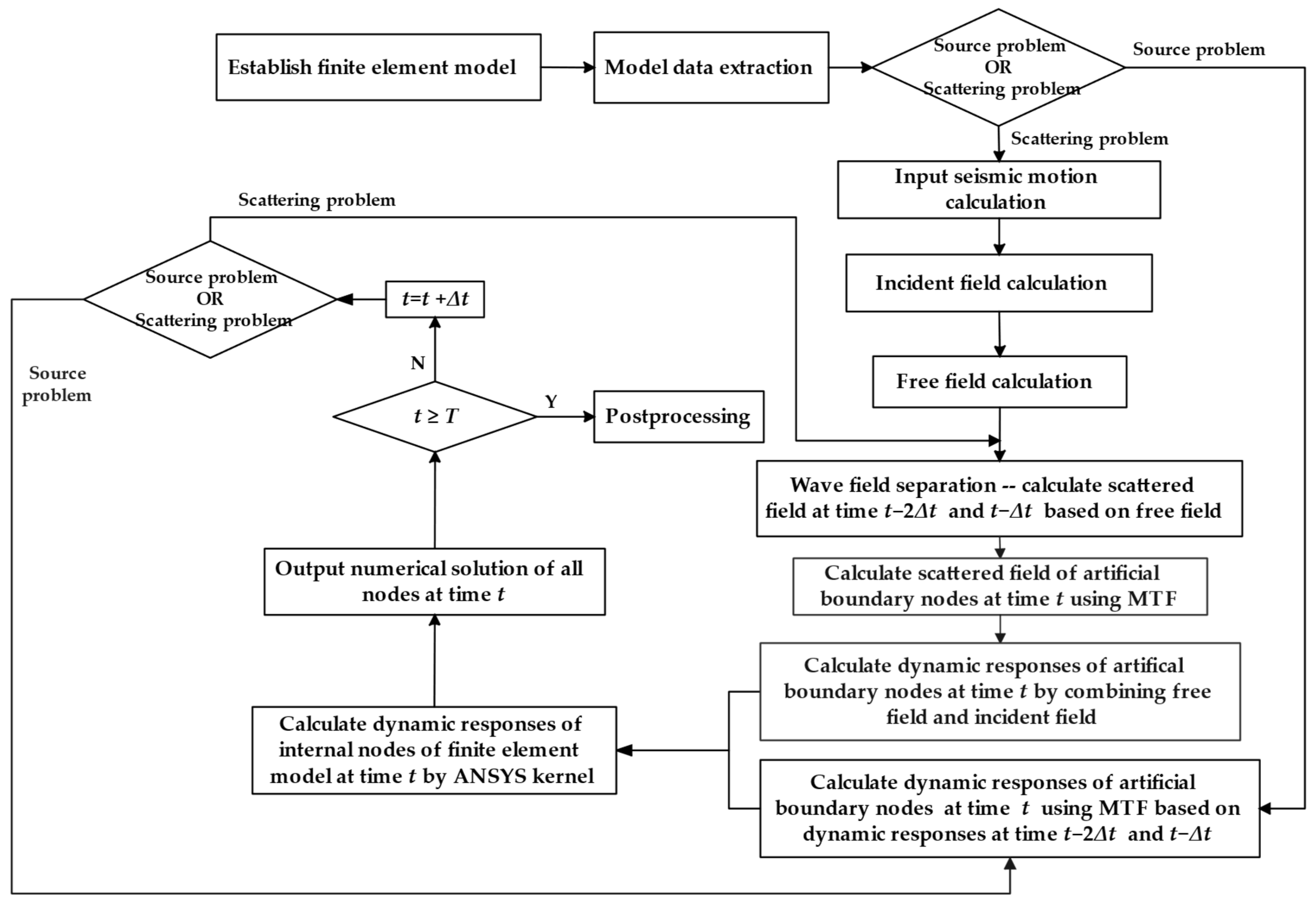
2.3. Determination of Element Size and Time Increment
3. Verification of MTF’s Stable Implementation in ANSYS
3.1. Scattering Problem
3.2. Source Problem
4. Field Observation and Analysis of Railway-Induced Environmental Vibration
4.1. Field Observation
4.2. Numerical Analysis
5. Conclusions
- (1)
- The MTF exhibits high computational accuracy. In the scattering problem, its numerical solutions match the analytical solution well based on the layered steady-state wave theory, while in the source problem, its results align closely with those obtained using the remote boundary.
- (2)
- The performance of the MTF in dynamic finite element analysis of open systems is superior to that of other artificial boundary conditions, such as viscous boundary and viscous-spring boundary, without numerical drift or oscillation caused by energy reflection at artificial boundaries.
- (1)
- The significant amplification of peak acceleration in the mud clay layer is due to the combined effect of piles and the soft clay layer. The vibration energy is directly transmitted through the piles into soil layers under the soft soil layer. Some of the energy propagates upward and amplifies within the soft soil layer, compounded by vibrations from the ground surface, resulting in further amplification.
- (2)
- The combined effect of piles and subsoils can effectively reduce vibration intensity at nearby sites along railway lines induced by high-speed train operation.
Author Contributions
Funding
Data Availability Statement
Conflicts of Interest
References
- Yang, Y.; Li, J.; Wu, W. Modeling Wave Propagation across Rock Masses Using an Enriched 3D Numerical Manifold Method. Sci. China Technol. Sci. 2024, 67, 835–852. [Google Scholar] [CrossRef]
- Chen, W.Y. Analysis of Dynamic Characteristics of Pile-Soil Coupling Effect in Consideration of Large Span Cable-Stayed Bridge. Appl. Mech. Mater. 2014, 501–504, 1270–1273. [Google Scholar] [CrossRef]
- Cen, H.; Zong, Z.; Huang, D.; Wang, H.; Zhuang, X.; Huang, Z.; Tang, A. Study of the Dynamic Interactions between Helix-Stiffened Cement Mixing Piles and Soft Soil under Oblique Incidence of SV Waves in Arbitrary Space. Comput. Geotech. 2024, 171, 106388. [Google Scholar] [CrossRef]
- Li, M.; Meng, K.; Zhou, J.; Zhang, J.; Zhong, G.; Song, S. Seismic Response and Damage Analysis of Shield Tunnel with Bottom Karst Caves under Oblique SV Waves. Nat. Hazards 2024, 120, 2731–2747. [Google Scholar] [CrossRef]
- Su, J.; Zhou, Z.; Li, Y.; Hao, B.; Dong, Q.; Li, X. A Stable Implementation Measure of Multi-Transmitting Formula in the Numerical Simulation of Wave Motion. PLoS ONE 2020, 15, e0243979. [Google Scholar] [CrossRef]
- Tang, H.; Rong, M.-S. An Improved Wave Motion Input Method for Application of Multi-Transmitting Boundary. Wave Motion 2020, 97, 102600. [Google Scholar] [CrossRef]
- Xing, H.; Li, X.; Li, H.; Liu, A. Spectral-Element Formulation of Multi-Transmitting Formula and Its Accuracy and Stability in 1D and 2D Seismic Wave Modeling. Soil. Dyn. Earthq. Eng. 2021, 140, 106218. [Google Scholar] [CrossRef]
- Xing, H.; Li, X.; Li, H.; Xie, Z.; Chen, S.; Zhou, Z. The Theory and New Unified Formulas of Displacement-Type Local Absorbing Boundary Conditions. Bull. Seismol. Soc. Amer 2021, 111, 801–824. [Google Scholar] [CrossRef]
- Yang, Y.; Li, X.; Rong, M.; Yang, Z. Strategy for Eliminating High-Frequency Instability Caused by Multi-Transmitting Boundary in Numerical Simulation of Seismic Site Effect. Front. Earth Sci. 2022, 10, 1056583. [Google Scholar] [CrossRef]
- Yu, Y.; Ding, H.; Zhang, X. Formulation and Performance of Multi-Transmitting Formula with Spectral Element Method in 2D Ground Motion Simulations Under Plane-Wave Incidence: SV Wave Problem. J. Earthq. Eng. 2024, 28, 1837–1860. [Google Scholar] [CrossRef]
- Haji, T.K.; Faramarzi, A.; Metje, N.; Chapman, D.; Rahimzadeh, F. Development of an Infinite Element Boundary to Model Gravity for Subsurface Civil Engineering Applications. Int. J. Numer. Anal. Methods Geomech. 2020, 44, 418–431. [Google Scholar] [CrossRef]
- Khalil, A.E.; Hameed, M.F.O.; Obayya, S.S.A. Leaky Mode Analysis Using Complex Infinite Elements. Opt. Quantum Electron. 2024, 56, 106. [Google Scholar] [CrossRef]
- Dastour, H.; Liao, W. A Fourth-Order Optimal Finite Difference Scheme for the Helmholtz Equation with PML. Comput. Math. Appl. 2019, 78, 2147–2165. [Google Scholar] [CrossRef]
- Kumar, R.; Sharma, A. Absorbing Boundary Condition (ABC) and Perfectly Matched Layer (PML) in Numerical Beam Propagation: A Comparison. Opt. Quantum Electron. 2019, 51, 53. [Google Scholar] [CrossRef]
- Zhuang, M.; Zhan, Q.; Zhou, J.; Guo, Z.; Liu, N.; Liu, Q.H. A Simple Implementation of PML for Second-Order Elastic Wave Equations. Comput. Phys. Commun. 2020, 246, 106867. [Google Scholar] [CrossRef]
- Wang, Y.; Zhou, M.; Cao, Y.; Wang, X.; Li, Z.; Ma, M. Simplified Tunnel–Soil Model Based on Thin-Layer Method–Volume Method–Perfectly Matched Layer Method. Appl. Sci. 2024, 14, 5692. [Google Scholar] [CrossRef]
- Ya, R.; Wu, J.; Tang, R.; Yang, Y.; Wang, L. Multi-Hazard Direct Economic Loss Risk Assessment on the Tibet Plateau. Geomat. Nat. Hazards Risk 2024, 15, 2368075. [Google Scholar] [CrossRef]
- Ding, Z.; Chen, Y.; Zi, H. Study on Artificial Boundary and Ground Motion Input Method in Tunnel Seismic Response. Earthq. Eng. Eng. Dyn. 2022, 42, 52–61. [Google Scholar] [CrossRef]
- Yu, H.; Wang, Z. Efficient Hybrid Simulation Method for Seismic Response Analysis of Underground Structures. Chin. J. Geotech. Eng. 2024, 46, 45–53. [Google Scholar]
- Zhao, C. Coupled Method of Finite and Dynamic Infinite Elements for Simulating Wave Propagation in Elastic Solids Involving Infinite Domains. Sci. China Technol. Sci. 2010, 53, 1678–1687. [Google Scholar] [CrossRef]
- Xu, G.; Duan, W.-Y. Time-Domain Simulation of Wave–Structure Interaction Based on Multi-Transmitting Formula Coupled with Damping Zone Method for Radiation Boundary Condition. Appl. Ocean Res. 2013, 42, 136–143. [Google Scholar] [CrossRef]
- Yu, Y.; Ding, H.; Zhang, X. Simulations of Ground Motions under Plane Wave Incidence in 2D Complex Site Based on the Spectral Element Method (SEM) and Multi-Transmitting Formula (MTF): SH Problem. J. Seismolog. 2021, 25, 967–985. [Google Scholar] [CrossRef]
- Shi, L.; He, J.; Huang, Z.; Sun, H.; Yuan, Z. Numerical Investigations on Influences of Tunnel Differential Settlement on Saturated Poroelastic Ground Vibrations and Lining Forces Induced by Metro Train. Soil. Dyn. Earthq. Eng. 2022, 156, 107202. [Google Scholar] [CrossRef]
- Jirong, S.; Shaolin, C.; Jiao, Z.; Puxin, C. Unified Framework Based Parallel FEM Code for Simulating Marine Seismoacoustic Scattering. Front. Earth Sci. 2023, 10, 1056485. [Google Scholar] [CrossRef]
- Xie, Z.; Zhang, X. Analysis of High-Frequency Local Coupling Instability Induced by Multi-Transmitting Formula–P-SV Wave Simulation in a 2D Waveguide. Earthq. Eng. Eng. Vib. 2017, 16, 1–10. [Google Scholar] [CrossRef]
- Di, G.; Xie, Z.; Guo, J. Predict the Influence of Environmental Vibration from High-Speed Railway on Over-Track Buildings. Sustainability 2021, 13, 3218. [Google Scholar] [CrossRef]
- Zhang, Y.; Lou, Y.; Zhang, N.; Cao, Y.; Chen, L. Attenuation and Prediction of the Ground Vibrations Induced by High-Speed Trains Running Over Bridge. Int. J. Struct. Stab. Dyn. 2021, 21, 2150076. [Google Scholar] [CrossRef]
- Çelebi, E.; Zülfikar, A.C.; Göktepe, F.; Kırtel, O.; Faizan, A.A.; İstegün, B. In-Situ Measurements and Data Analysis of Environmental Vibrations Induced by High-Speed Trains: A Case Study in North-Western Turkey. Soil. Dyn. Earthq. Eng. 2022, 156, 107211. [Google Scholar] [CrossRef]
- Faizan, A.A.; Kırtel, O.; Çelebi, E.; Zülfikar, A.C.; Göktepe, F. Experimental Validation of a Simplified Numerical Model to Predict Train-Induced Ground Vibrations. Comput. Geotech. 2022, 141, 104547. [Google Scholar] [CrossRef]
- Zheng, H.; Yan, W. Field and Numerical Investigations on the Environmental Vibration and the Influence of Hill on Vibration Propagation Induced by High-Speed Trains. Constr. Build. Mater. 2022, 357, 129378. [Google Scholar] [CrossRef]
- Niu, D.; Deng, Y.; Mu, H.; Chang, J.; Xuan, Y.; Cao, G. Attenuation and Propagation Characteristics of Railway Load-Induced Vibration in a Loess Area. Transp. Geotech. 2022, 37, 100858. [Google Scholar] [CrossRef]
- Wang, C.; Lei, X.; Wang, P.; Liu, W. Study of Ground Vibration Caused by High-Speed Trains Through Bridges Based on Finite Element Model: Test Validation. KSCE J. Civ. Eng. 2024, 28, 3758–3767. [Google Scholar] [CrossRef]
- Zheng, H.; Yan, W. Experimental and Numerical Studies on Environmental Vibration Characteristics of Pier and Foundation Sites Caused by High-Speed Trains in Seasonally Frozen Regions. Acta Geotech. 2024, 19, 305–326. [Google Scholar] [CrossRef]
- İstegün, B.; Çelebi, E.; Kırtel, O.; Faizan, A.A.; Göktepe, F.; Zülfikar, A.C.; Subaşı, A.; Navdar, M.B. Mitigation of High-Speed Train-Induced Environmental Ground Vibrations Considering Open Trenches in the Soft Soil Conditions by in-Situ Tests. Transp. Geotech. 2023, 40, 100980. [Google Scholar] [CrossRef]
- Auersch, L. Reduction of Train-Induced Vibrations—Calculations of Different Railway Lines and Mitigation Measures in the Transmission Path. Appl. Sci. 2023, 13, 6706. [Google Scholar] [CrossRef]
- Çelebi, E.; Kırtel, O.; İstegün, B.; Göktepe, F.; Burhan Navdar, M.; Subaşı, A.; Can Zülfikar, A. Mitigation of High-Speed Train Induced Surface Vibrations by Open Trench with Aerated Concrete Panel Walls. Constr. Build. Mater. 2023, 400, 132771. [Google Scholar] [CrossRef]
- Barman, R.; Sarkar, A.; Bhowmik, D. Composite Sand-Crumb Rubber and Geofoam Wave Barrier for Train Vibration. Geotech. Geol. Eng. 2024, 42, 2321–2343. [Google Scholar] [CrossRef]
- Çelebi, E.; Kırtel, O.; İstegün, B.; Navdar, M.B.; Subaşı, A.; Göktepe, F.; Zülfikar, A.C. High-Speed Train Induced Environmental Vibrations: Experimental Study on Isolation Efficiency of Recyclable in-Filling Materials for Thin-Walled Hollow Wave Barrier. Eng. Struct. 2024, 312, 118207. [Google Scholar] [CrossRef]
- Coulier, P.; Hunt, H.E.M. Experimental Study of a Stiff Wave Barrier in Gelatine. Soil. Dyn. Earthq. Eng. 2014, 66, 459–463. [Google Scholar] [CrossRef]
- Dijckmans, A.; Ekblad, A.; Smekal, A.; Degrande, G.; Lombaert, G. Efficacy of a Sheet Pile Wall as a Wave Barrier for Railway Induced Ground Vibration. Soil. Dyn. Earthq. Eng. 2016, 84, 55–69. [Google Scholar] [CrossRef]
- Andersen, L.; Nielsen, S.R.K. Reduction of Ground Vibration by Means of Barriers or Soil Improvement along a Railway Track. Soil. Dyn. Earthq. Eng. 2005, 25, 701–716. [Google Scholar] [CrossRef]
- Dijckmans, A.; Coulier, P.; Jiang, J.; Toward, M.G.R.; Thompson, D.J.; Degrande, G.; Lombaert, G. Mitigation of Railway Induced Ground Vibration by Heavy Masses next to the Track. Soil. Dyn. Earthq. Eng. 2015, 75, 158–170. [Google Scholar] [CrossRef]
- Gao, G.; Li, N.; Gu, X. Field Experiment and Numerical Study on Active Vibration Isolation by Horizontal Blocks in Layered Ground under Vertical Loading. Soil. Dyn. Earthq. Eng. 2015, 69, 251–261. [Google Scholar] [CrossRef]
- Gao, G.; Zhang, Q.; Chen, J.; Chen, Q. Field Experiments and Numerical Analysis on the Ground Vibration Isolation of Wave Impeding Block under Horizontal and Rocking Coupled Excitations. Soil. Dyn. Earthq. Eng. 2018, 115, 507–512. [Google Scholar] [CrossRef]
- Gao, M.; Tian, S.P.; Wang, Y.; Chen, Q.S.; Gao, G.Y. Isolation of Ground Vibration Induced by High Speed Railway by DXWIB: Field Investigation. Soil. Dyn. Earthq. Eng. 2020, 131, 106039. [Google Scholar] [CrossRef]
- Tsai, P.; Feng, Z.; Jen, T. Three-Dimensional Analysis of the Screening Effectiveness of Hollow Pile Barriers for Foundation-Induced Vertical Vibration. Comput. Geotech. 2008, 35, 489–499. [Google Scholar] [CrossRef]
- Liu, X.; Shi, Z.; Mo, Y.L. Comparison of 2D and 3D Models for Numerical Simulation of Vibration Reduction by Periodic Pile Barriers. Soil. Dyn. Earthq. Eng. 2015, 79, 104–107. [Google Scholar] [CrossRef]
- Li, Z.; Ma, M.; Liu, K.; Jiang, B. Performance of Rubber-Concrete Composite Periodic Barriers Applied in Attenuating Ground Vibrations Induced by Metro Trains. Eng. Struct. 2023, 285, 116027. [Google Scholar] [CrossRef]
- Wu, L.; Shi, Z. Feasibility of Vibration Mitigation in Unsaturated Soil by Periodic Pile Barriers. Comput. Geotech. 2023, 164, 105798. [Google Scholar] [CrossRef]
- Coulier, P.; François, S.; Degrande, G.; Lombaert, G. Subgrade Stiffening next to the Track as a Wave Impeding Barrier for Railway Induced Vibrations. Soil. Dyn. Earthq. Eng. 2013, 48, 119–131. [Google Scholar] [CrossRef]
- Li, S.; Liao, Z.; Zhou, Z. Wave Motion Input in Numerical Simulation of Seismic Response for Large-scale Structure. Earthq. Eng. Eng. Vib. 2001, 21, 1–5. [Google Scholar] [CrossRef]
- Zhou, Z.; Liao, Z. A Measure for Eliminating Drift Instability of the Multi-transmitting Formula. Acta Mech. Sin. 2001, 33, 550–554. [Google Scholar]
- Tang, H.; Li, X. Analysis of Measures of Eliminating Drift Instability of Multi-transmission Formula in Solving Scattering Problem. J. Seismol. Res. 2019, 42, 493–502+649. [Google Scholar]
- Yang, G.; Liao, Z. Finite Element Simulation of Steady Wave Motion in the Visco-elastic Layered Medium. Rock Soil Mech. 1993, 14, 41–48. [Google Scholar] [CrossRef]
- Liu, H.; Zhou, Y.; Zhong, K.; Zhou, Z.; Li, Y.; Dong, Q.; Wang, W.; Song, J. Variation Characteristics of Foundation Soil Vibaration Caused by High speed Train with Depth under Different Site Conditions. Technol. Earthq. Disaster Prev. 2018, 13, 893–902. [Google Scholar] [CrossRef]
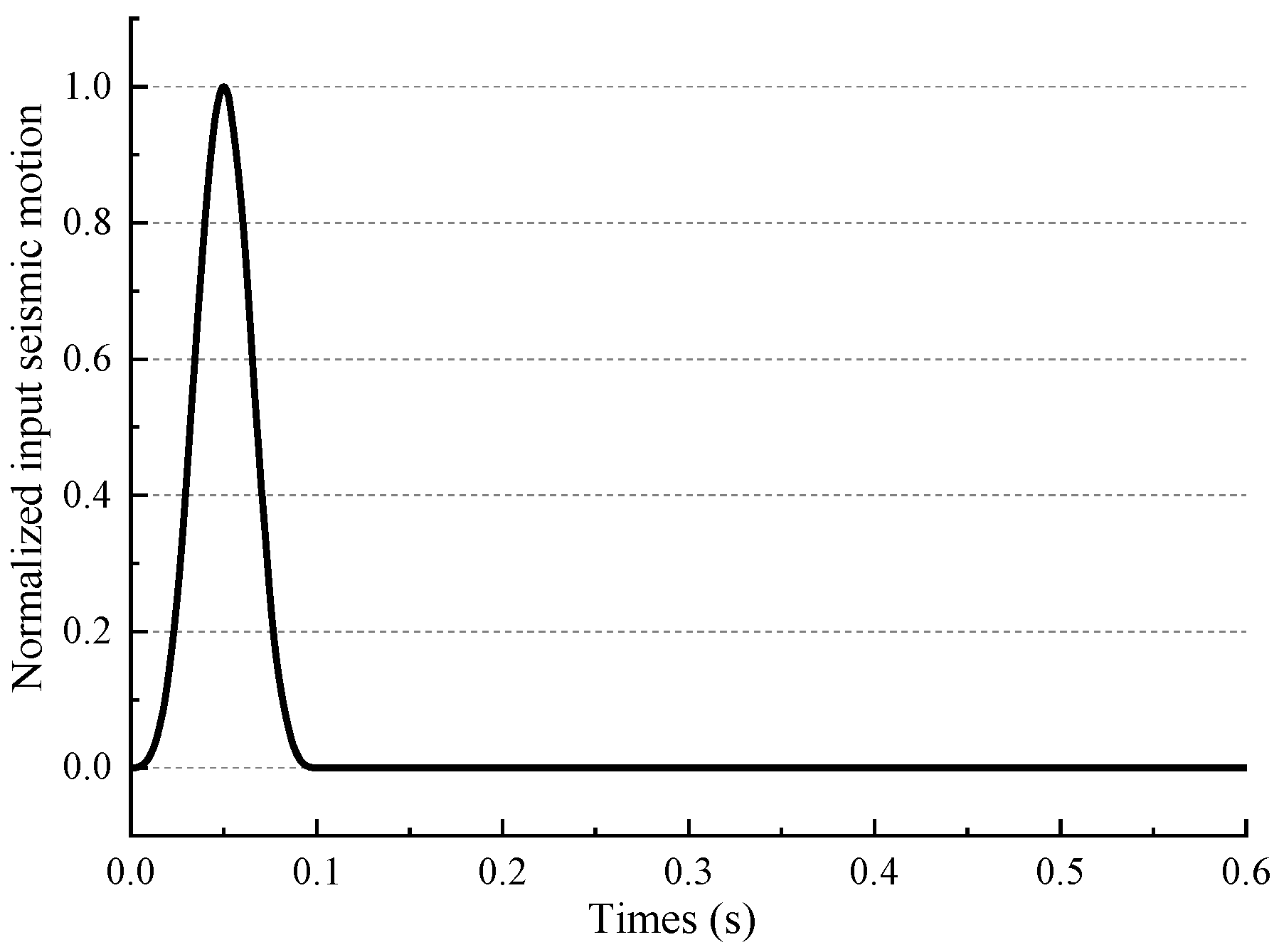



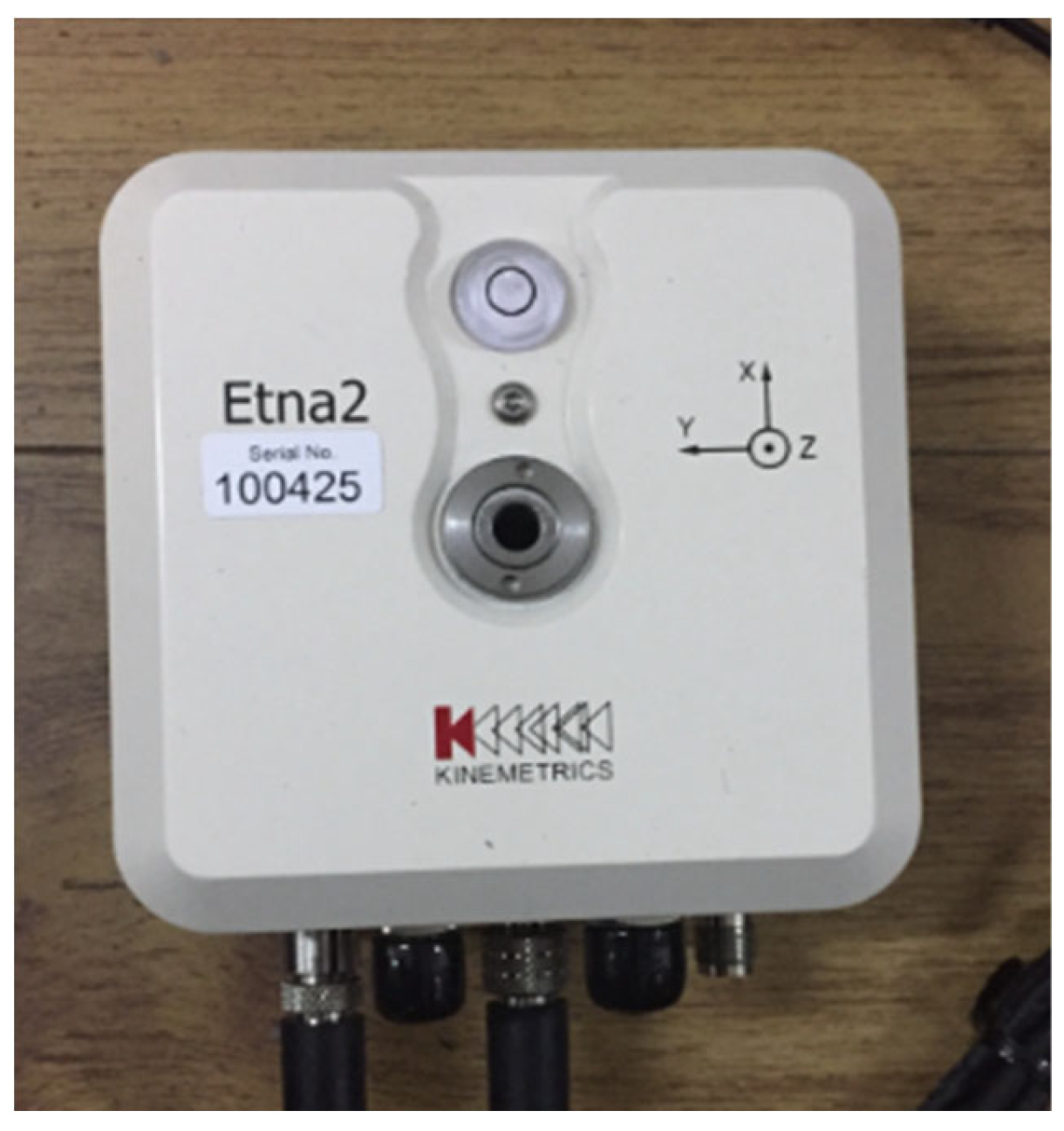
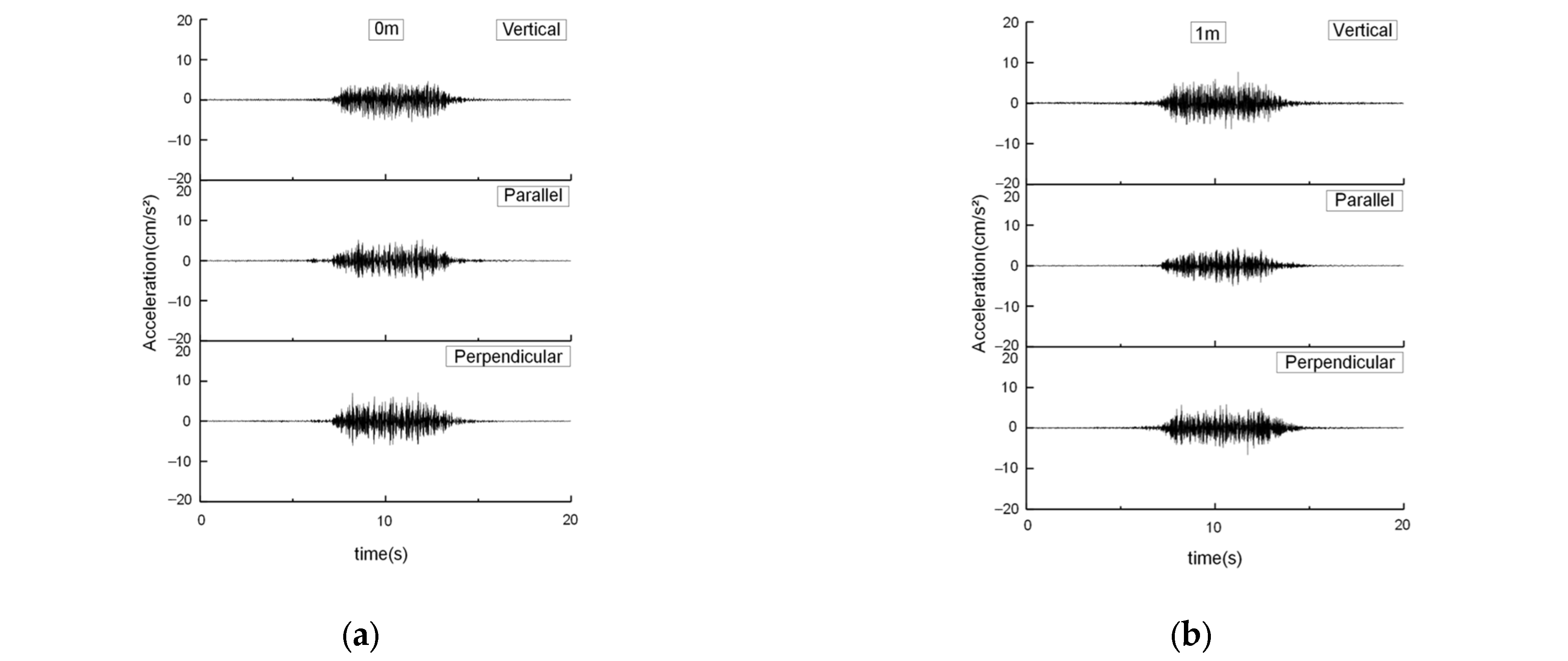
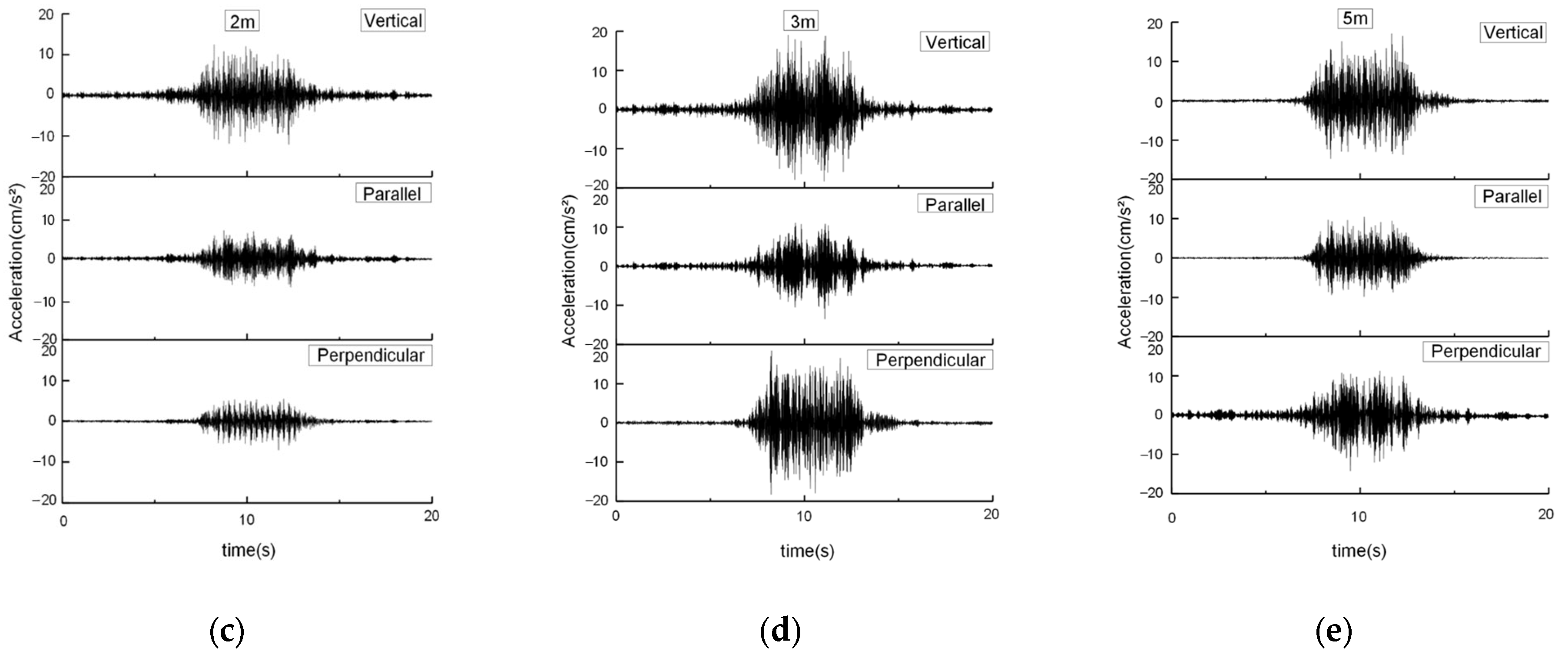


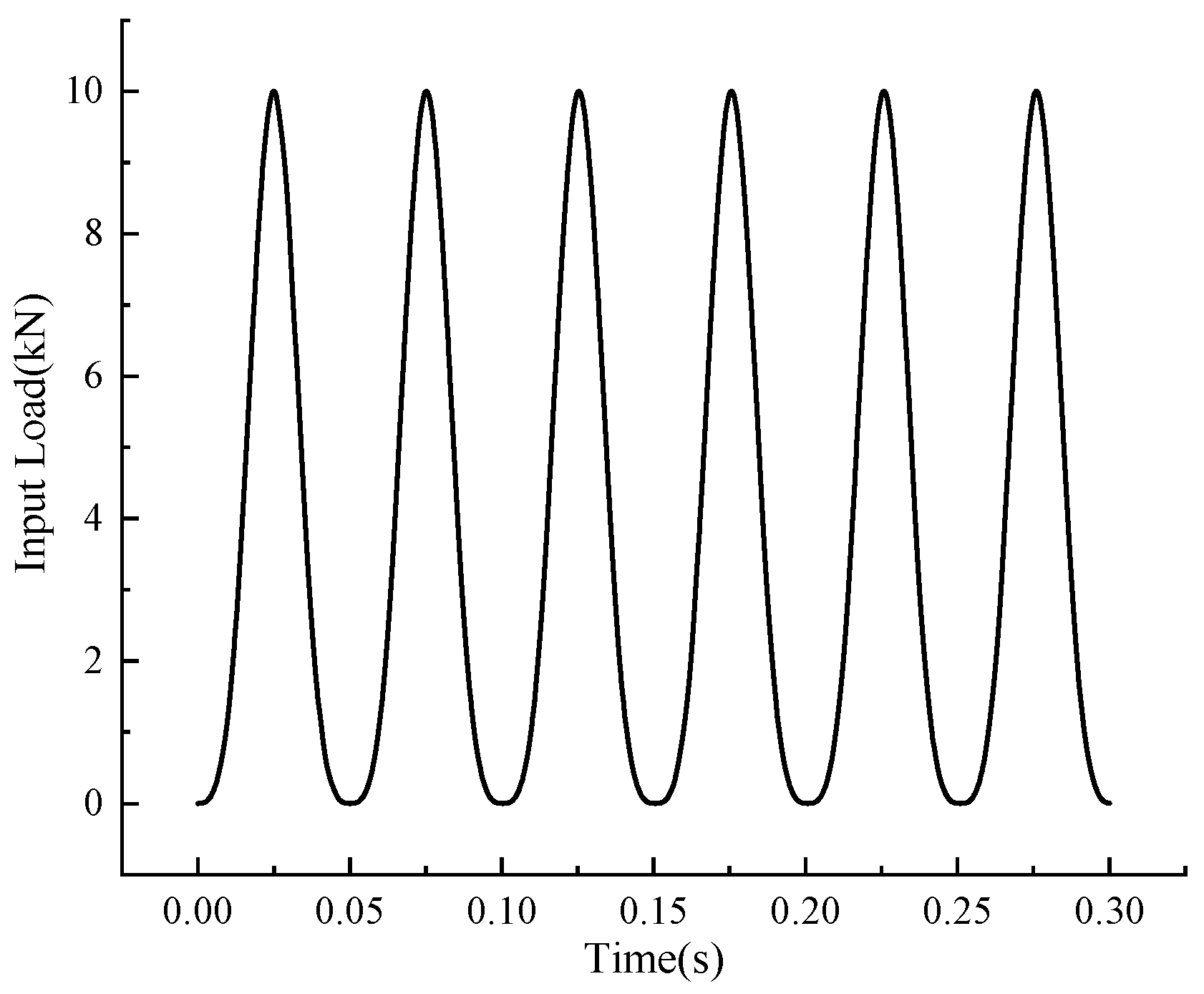


| No. | Soil Layer Description | Layer Thickness (m) | Shear Wave Velocity (m/s) | Density (kg/m3) | Poisson’s Ratio |
|---|---|---|---|---|---|
| 1 | Mud clay | 2 | 118.3 | 1950 | 0.3 |
| 2 | Silty clay | 3 | 217.5 | 1790 | 0.3 |
| 3 | Silty clay | 5 | 254.5 | 1790 | 0.3 |
| No. | Soil Properties | Layer Bottom Depth (m) | Layer Thickness (m) | Shear Wave Velocity vs (m/s) | Density (t/m3) |
|---|---|---|---|---|---|
| ① | Silty clay | 2 | 2 | 245.0 | 1.79 |
| ② | Mud clay | 5 | 3 | 100.0 | 1.95 |
| ③ | Silty clay | 8 | 3 | 217.5 | 1.79 |
| ④ | Silty clay | 12 | 4 | 254.5 | 1.79 |
| ⑤ | Silty soil | 17 | 5 | 391.0 | 1.87 |
Disclaimer/Publisher’s Note: The statements, opinions and data contained in all publications are solely those of the individual author(s) and contributor(s) and not of MDPI and/or the editor(s). MDPI and/or the editor(s) disclaim responsibility for any injury to people or property resulting from any ideas, methods, instructions or products referred to in the content. |
© 2024 by the authors. Licensee MDPI, Basel, Switzerland. This article is an open access article distributed under the terms and conditions of the Creative Commons Attribution (CC BY) license (https://creativecommons.org/licenses/by/4.0/).
Share and Cite
Zhong, K.; Li, X.; Zhou, Z. High-Speed Train-Induced Vibration of Bridge–Soft Soil Systems: Observation and MTF-Based ANSYS Simulation. Buildings 2024, 14, 2575. https://doi.org/10.3390/buildings14082575
Zhong K, Li X, Zhou Z. High-Speed Train-Induced Vibration of Bridge–Soft Soil Systems: Observation and MTF-Based ANSYS Simulation. Buildings. 2024; 14(8):2575. https://doi.org/10.3390/buildings14082575
Chicago/Turabian StyleZhong, Kangming, Xiaojun Li, and Zhenghua Zhou. 2024. "High-Speed Train-Induced Vibration of Bridge–Soft Soil Systems: Observation and MTF-Based ANSYS Simulation" Buildings 14, no. 8: 2575. https://doi.org/10.3390/buildings14082575





